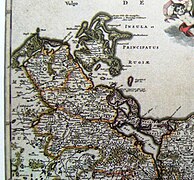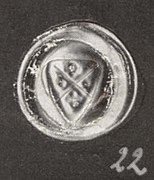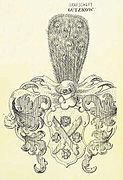County of Gützkow
The county of Gützkow was a subordinate rule within the Duchy of Pomerania .
history
principality
The Lutizian principality of Gützkow was an independent rule with the center of Gützkow , in which there was also an important Slavic sanctuary, until the 12th century . At the time of Bishop Otto von Bamberg's second mission trip in 1128, Duke Wartislaw I of Pomerania had already subjugated the principality. Otto's chroniclers name a Prince Mitzlaw von Gützkow . The principality was converted into a castellany by the Pomeranian dukes . In 1164 and 1177 the area was the target of several Danish and Saxon military campaigns.
county
A Mr. Wartislaw von Gützkow is named in a document of the Pomeranian Duke Casimir II from 1218/1220. This Wartislaw was sometimes equated with the Wartislaw († 1233) , who came from a sideline of the ducal house , but this is just a presumption that cannot be proven. In a deed of donation to the Stolpe Monastery from 1226, Dobroslawa, daughter of Duke Bogislaw II of Pomerania, is referred to as Countess to Gützkow . There is no documentary evidence that this Dobroslawa is identical to the wife of the same name, mentioned in 1248/1249, of the German bailiff Jaczo von Salzwedel , who is considered the founder of the Gützkow family of counts. As the seat of the counts, the castle was built on today's Gützkower Schlossberg . The existing Slavic prince's castle was fortified as a solid stone structure.
Around 1230, the Pomeranian dukes began to encourage the influx of German settlers into the central and northern lands of the Gützkow area, which were sparsely populated due to the numerous armed conflicts of the 12th century. The Gützkow lords, as feudal men of the dukes, actively supported the settlement, as the name of the place Hanshagen shows, which is traced back to Count Johannes I. von Gützkow . Conrad II von Salzwedel , Jaczo's brother, who came into office in 1233 , favored Konrad III as Bishop. von Cammin his Gützkower relatives several times, in which he enfeoffed them with income from the Usedom monastery property.
The foundation of the Franciscan monastery in Greifswald ascribed to Jaczo and Dobroslawa by Robert Klempin for 1242 is now considered unprovable. At times the counts also ran their own mint.
The title of Count von Gützkow is documented from 1249. Jaczo's sons Johann I and Konrad were called Lords of Gützkow until 1270 . Konrad was the first named Count von Gützkow . Jaczo II was engaged to the 2-year-old Cecislawa von Putbus , from a sideline of the princes of Rügen, who he married in 1262 at the age of 5 in 1249 . With the terra litter received as a dowry , he became a feudal lord of the princes. Jaczo II. And Cecislawa founded the Franciscan monastery in Greifswald in 1262 , which housed the burial place of the Gützkow count family. In 1295 Jaczo II appeared as the first witness in the division of Pomerania. The county was subordinated to the Duchy of Pomerania-Wolgast. His grandson, Count Nikolaus von Gützkow , was appointed chief judge of a district court against muggers in the Peene area by Duke Wartislaw IV of Pommern-Wolgast in 1319 .
Countess Barbara von Gützkow was abbess of the Krummin Monastery on Usedom from 1302 to 1326.
Under Johann III. and IV. There were disputes over the dowry her mother Margaret with the Pomeranian Dukes. Margarete's brother, Bogislaw IV. Had given the Gützkower Counts the goods Konsages , Schlatkow and Bünzow. Probably when Wartislaw IV reclaimed them, they ignored their feudal obligations and supported the Mecklenburg princes at the beginning of the first War of Succession . After the battle of Griebenow an agreement was reached with the Pomeranian dukes and the counts switched back to the side of their liege lord. In 1327 they besieged the city of Barth for several days . In April 1328 an army led by the Counts of Gützkow with support from the towns of Demmin and Treptow near Völschow defeated the troops of Prince Heinrich II of Mecklenburg and the peace of Brodersdorf.
In the years 1329 to 1334, the Counts Johann III supported. the elder and his brother Johann IV. the younger the dukes of Pomerania-Stettin in the Pomeranian-Brandenburg War with the Margraves of Brandenburg . They were also involved in the battle at Kremmer Damm in 1331 (1334) . There Johann IV was seriously wounded and he died in Gützkow in 1334 and was buried in the Gray Monastery in Greifswald. The war costs, which the counts had to bear as feudal men of the dukes, forced them to sell several goods, including Sanz , Müssow and Güst, to the citizens of Greifswald between 1334 and 1351 .
With the death of Count Johannes V. von Gützkow on October 25, 1351 in the battle on Schoppendamm near Loitz during the Second War of the Rügen Succession and with the death of his uncle after 1359, the Gützkow Counts died out in the male line. In 1378 the sisters Elisabeth and Mechtild were still mentioned as residents of Gützkower Castle. The county of Gützkow as a fiefdom was withdrawn by the Pomeranian feudal lords on May 27, 1372 at the latest, who from then on called themselves Counts of Gützkow. The Gützkower coat of arms was inserted into the coat of arms of Pomerania ; in the five-field it formed the fifth, in the nine-field the eighth.
From 1466 onwards, Wartislaw X. held the title of Count von Gützkow, and later Bogislaw X. The German emperors Maximilian I , Karl V and Ferdinand I also added the title of Count von Gützkow to the Pomeranian dukes. After the Thirty Years' War the title went to the Swedish crown. After 1815, the Prussian kings took over the title, in Köpenick Castle a large coat of arms of the county hangs in the coat of arms hall, after Elector Friedrich Wilhelm von Brandenburg had already adopted the Gützkow count coat of arms in his throne seal in 1648. The title didn't end until 1918.
Territorial development
The county originally extended over the territory of the previous principality of Gützkow. In the north the Ryck and in the northeast the Ziese formed the border. In the east the areas of Züssow , Ranzin, Vitense, Owstin and Groß Polzin , possibly also Giesekenhagen , Buggow and Wahlendow belonged to the territory. Schlatkow , Konsages and Groß- and Klein- Bünzow were added to the marriage property in 1303 . To the west the county extended to Dersekow. In the south, the lands of Miserez and Ploth south of the Peene were also part of it. At the end of the 12th century, the Loitz region was temporarily assigned to Gützkower Castle.
Even before the establishment of the county, lands or their use on both sides of the Peene were assigned to the newly founded Stolpe Monastery by the Pomeranian dukes. Land south of the Ryck was donated by Prince Jaromar I of Rügen to the Eldena Monastery, while this was on the orders of the Danish King Knut VI. 1189-1212 as a guardian for the minor children of the Pomeranian Duke Bogislaw I worked. According to the border treaty of 1249, the swing formed the border between counts and monasteries.
The Gützkow counts were feudal lords themselves. As vassals, they were subordinate to around 18 knight families, including members of the von Behr , von Horn , von Winterfeld , von Owstin and von Heyden families , some of whom were also vassals of the dukes of Pomerania and the dukes of Mecklenburg.
- Historical map displays
Detail map of Pomerania by de Wit , 1690
Lubin map of Pomerania, 1618 - colored 1758
Map of Western Pomerania from Seutters , around 1760
It is not the boundaries of the historical county, it appears to be Swedish administrative districts, but this has not yet been proven, except in these maps. See Schreiber card - legend at the top right.
coat of arms
The family coat of arms shows a red diagonal or St. Andrew's cross angled with four red roses . On the helmet with red and gold covers, a natural peacock bump consisting of seven feathers.
Later representations in the coat of arms of the Pomeranian dukes often show two red stumped branches or sticks placed in the St. Andrew's cross, accompanied by the four red roses.
- Historical coats of arms
Duke coat of arms with the county of Gützkow in the Croy carpet from 1454
Relatives
- Barbara von Gützkow († before 1323), gent. 1303 as abbot in Krummin
- Bernhard von Gützkow (⚔ September 7, 1319 near Oldenwöhrden ), 1315 participant in the margravial war on the side of Witzlaw von Rügen , originally in 1317 at the Peace of Templin as part of Erich of Denmark
- Catharina von Gützkow, ∞ King Woldemar of Sweden (* 1243; † 1302)
- Jaczo I. von Gützkow († before 1237/1248), urkdl. 1212–1235, ∞ NN , urkdl. 1249
- Jaczo II von Gützkow ((* 1244); † after 1295/1298), archd. (1249 and 1262) 1280–1297, (1298 lord of the terra streu on Rügen), ∞ (1262) Cacislawa von Putbus ((* 1247); † after 1295), daughter of Stoislaw II of Vilmnitz and Greta von Pedebuz
- Jaczo III. (Jacob) von Gützkow († after May 16, 1303), urkdl. 1280–1303
- Johann I. von Gützkow († 1263/1269), urkdl. 1249–1257
- Johann II. Von Gützkow († after 1314), urkdl. 1290–1314
- Johann III. von Gützkow († between January 16 and June 18, 1334), Urkdl. 1320, 1327
- Johann IV (Henning) von Gützkow († before May 27, 1372), original 1320–1359, ∞ around June 26, 1330, Mechthild von Schwerin († after 1378), daughter of Count Günzel VI. von Schwerin and the Richardis von Tecklenburg
- Johann V. von Gützkow (⚔ October 25, 1351 on the Schoppendamm near Loitz), original dated 1330
- Konrad I. von Gützkow († after 1284), original 1249–1284, ∞ daughter of Prince Nikolaus I von Werle and Jutta von Anhalt
- Margarethe von Gützkow († after 1334), urkdl. 1322, 1330, 1334, ∞ between April 21, 1320 a. July 30, 1322 in Trankær, Laurentz Jonsson Panter (* around 1280; † April 2/6, 1340), Danish Reichsdrost
- Nikolaus von Gützkow († (after) 1322), urkdl. 1304, 1315, 1317, 1320
- Verenbert von Gützkow, urkdl. 1284 (u. 1300?)
literature
- Theodor Pyl : Jaczo von Salzwedel . In: Allgemeine Deutsche Biographie (ADB). Volume 13, Duncker & Humblot, Leipzig 1881, pp. 633-636.
- Theodor Pyl: Johann III. and IV. In: Allgemeine Deutsche Biographie (ADB). Volume 14, Duncker & Humblot, Leipzig 1881, pp. 218-221.
- Theodor Pyl: The counts of Gützkow and noblemen of Salzwedel. In: Ders .: The development of the Pomeranian coat of arms in connection with the Pomeranian Landestheilungen (= Pomeranian historical monuments , 7), Greifswald 1894, pp. 207–215
- Walter Ewert : The time of the counts of Gützkow . In: Unser Pommerland 10 (1925), H. 12, P. 477-480.
- Johannes Hoffmann: Studies on the history of the counts of Gützkow. Dissertation, University of Greifswald 1946
- Adolf Hofmeister : The counts of Gützkow and the Pomeranian ducal house. In: Ders .: Genealogical studies on the history of the Pomeranian ducal house (= Greifswald treatises on the history of the Middle Ages , vol. 11), Greifswald / Bamberg 1938, pp. 50–63 ( digitized version )
- Roderich Schmidt : Gützkow, Count of. In: New German Biography (NDB). Volume 7, Duncker & Humblot, Berlin 1966, ISBN 3-428-00188-5 , p. 290 f. ( Digitized version ).
- Albert Georg von Schwarz : Diplomatic history of the Pomeranian-Rügischen cities of Swedish sovereignty: In addition to the attached history of the county of Gützkow. Hieronymus Johann Struck, Greifswald 1755, p. 707f. ( Google books ).
- Joachim Wächter : On the history of the settlement of the middle Peeneraum . In: Contributions to the history of Western Pomerania: the Demmin Colloquia 1985–1994 . Thomas Helms Verlag, Schwerin 1997, ISBN 3-931185-11-7 .
- Joachim Wächter: The Principality of Rügen - An overview . In: Contributions to the history of Western Pomerania: the Demmin Colloquia 1985–1994 . Thomas Helms Verlag, Schwerin 1997, ISBN 3-931185-11-7 .
- Werner Wöller: Prehistory and Early History, Middle Ages and Early Modern Times . In: Gützkow local history commission at the Gützkow city council (ed.): Local history of Gützkow and the surrounding area . Issue 2/1990, pp. 4-23.
Web links
- Gützkow Castle at the Mecklenburg-Western Pomerania cultural portal
Individual evidence
- ^ Klaus Conrad (arrangement): Pommersches Urkundenbuch . Volume 1. 2nd edition (= publications of the Historical Commission for Pomerania. Series 2, Vol. 1). Böhlau Verlag, Cologne / Vienna 1970, No. 190.
- ^ Martin Wehrmann : Genealogy of the Pomeranian ducal house. Publications of the regional historical research center for Pomerania, series 1, vol. 5. Leon Saunier, Stettin 1937, p. 52.
- ^ A b c Roderich Schmidt : Gützkow, Count of. In: New German Biography (NDB). Volume 7, Duncker & Humblot, Berlin 1966, ISBN 3-428-00188-5 , p. 290 f. ( Digitized version ).
- ↑ Werner Wöller: Heimatgeschichte von Gützkow and its surroundings, volume 2, p. 15.
- ↑ Wöller, p. 17
- ↑ a b Karsten Igel: On the history of the Greifswald Franciscan monastery. On the occasion of the 750th anniversary of the founding of the monastery on June 29, 1262. In: Greifswald contributions to city history, preservation of monuments, city renovation. 6th year, Hanseatic City of Greifswald, Stadtbauamt, Greifswald 2012, pp. 4–15.
- ↑ In 1937, 47 coins with the coat of arms of the Counts of Gützkow were discovered when Karrin was found. According to Carl Engel: Announcements Prehistory Uni Greifswald 1940 pp. 196–201
- ^ Mention of the counties and counts of Gützkow in the Codex diplomaticus Brandenburgensis , edited by Adolph Friedrich Riedel , Berlin 1838–1869.
- ↑ Albert Georg Schwartz: Diplomatic history. History of the county. S. 838 ff., § 98-100. ( Google books ).











